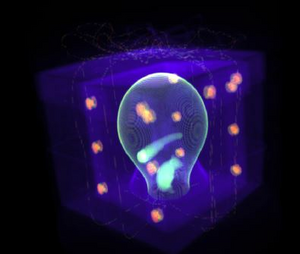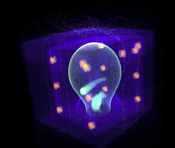Information
- Publication Type: Master Thesis
- Workgroup(s)/Project(s):
- Date: May 2021
- Date (Start): 10. July 2020
- Date (End): 7. May 2021
- TU Wien Library:
- Diploma Examination: 7. May 2021
- Open Access: yes
- First Supervisor: Ivan Viola

- Pages: 109
- Keywords: Volume Rendering, Transfer Function, Homomorphic-Encryption, Paillier, Big-Integer, GPU
Abstract
Computationally demanding tasks are typically calculated in dedicated data centers, and real-time visualizations also follow this trend. Some rendering tasks, however, require the highest level of confidentiality so that no other party, besides the owner, can read or see the sensitive data. Here we present a direct volume rendering approach that performs volume rendering directly on encrypted volume data by using the homomorphic Paillier encryption algorithm. This approach ensures that the volume data and rendered image are uninterpretable to the rendering server. Our volume rendering pipeline introduces novel approaches for encrypted-data compositing, interpolation, and opacity modulation, as well as simple transfer function design, where each of these routines maintains the highest level of privacy. We present performance and memory overhead analysis that is associated with our privacy-preserving scheme. Our approach is open and secure by design, as opposed to secure through obscurity. Owners of the data only have to keep their secure key confidential to guarantee the privacy of their volume data and the rendered images. Our work is, to our knowledge, the first privacy-preserving remote volume-rendering approach that does not require that any server involved be trustworthy; even in cases when the server is compromised, no sensitive data will be leaked to a foreign party. Furthermore, we developed a big-integer (multiple-precision, or multiple word integer) library for Vulkan graphics pipeline. It facilitates the rendering of securely encrypted data on the GPU. It supports the calculation of common mathematical operations like addition, subtraction, multiplication, division. Moreover, it supports specialized operations for asymmetric cryptography like modular exponentiation with Montgomery reduction. We also introduce a testing framework for Vulkan that allows the automated testing of big-integer computations on the GPU.
Additional Files and Images
Additional images and videos
Additional files
Weblinks
BibTeX
@mastersthesis{Mazza_2021_05,
title = "Homomorphic-Encrypted Volume Rendering",
author = "Sebastian Mazza",
year = "2021",
abstract = "Computationally demanding tasks are typically calculated in
dedicated data centers, and real-time visualizations also
follow this trend. Some rendering tasks, however, require
the highest level of confidentiality so that no other party,
besides the owner, can read or see the sensitive data. Here
we present a direct volume rendering approach that performs
volume rendering directly on encrypted volume data by using
the homomorphic Paillier encryption algorithm. This approach
ensures that the volume data and rendered image are
uninterpretable to the rendering server. Our volume
rendering pipeline introduces novel approaches for
encrypted-data compositing, interpolation, and opacity
modulation, as well as simple transfer function design,
where each of these routines maintains the highest level of
privacy. We present performance and memory overhead analysis
that is associated with our privacy-preserving scheme. Our
approach is open and secure by design, as opposed to secure
through obscurity. Owners of the data only have to keep
their secure key confidential to guarantee the privacy of
their volume data and the rendered images. Our work is, to
our knowledge, the first privacy-preserving remote
volume-rendering approach that does not require that any
server involved be trustworthy; even in cases when the
server is compromised, no sensitive data will be leaked to a
foreign party. Furthermore, we developed a big-integer
(multiple-precision, or multiple word integer) library for
Vulkan graphics pipeline. It facilitates the rendering of
securely encrypted data on the GPU. It supports the
calculation of common mathematical operations like addition,
subtraction, multiplication, division. Moreover, it supports
specialized operations for asymmetric cryptography like
modular exponentiation with Montgomery reduction. We also
introduce a testing framework for Vulkan that allows the
automated testing of big-integer computations on the GPU.",
month = may,
pages = "109",
address = "Favoritenstrasse 9-11/E193-02, A-1040 Vienna, Austria",
school = "Research Unit of Computer Graphics, Institute of Visual
Computing and Human-Centered Technology, Faculty of
Informatics, TU Wien",
keywords = "Volume Rendering, Transfer Function, Homomorphic-Encryption,
Paillier, Big-Integer, GPU",
URL = "https://www.cg.tuwien.ac.at/research/publications/2021/Mazza_2021_05/",
}

 Image
Image Master Thesis
Master Thesis

